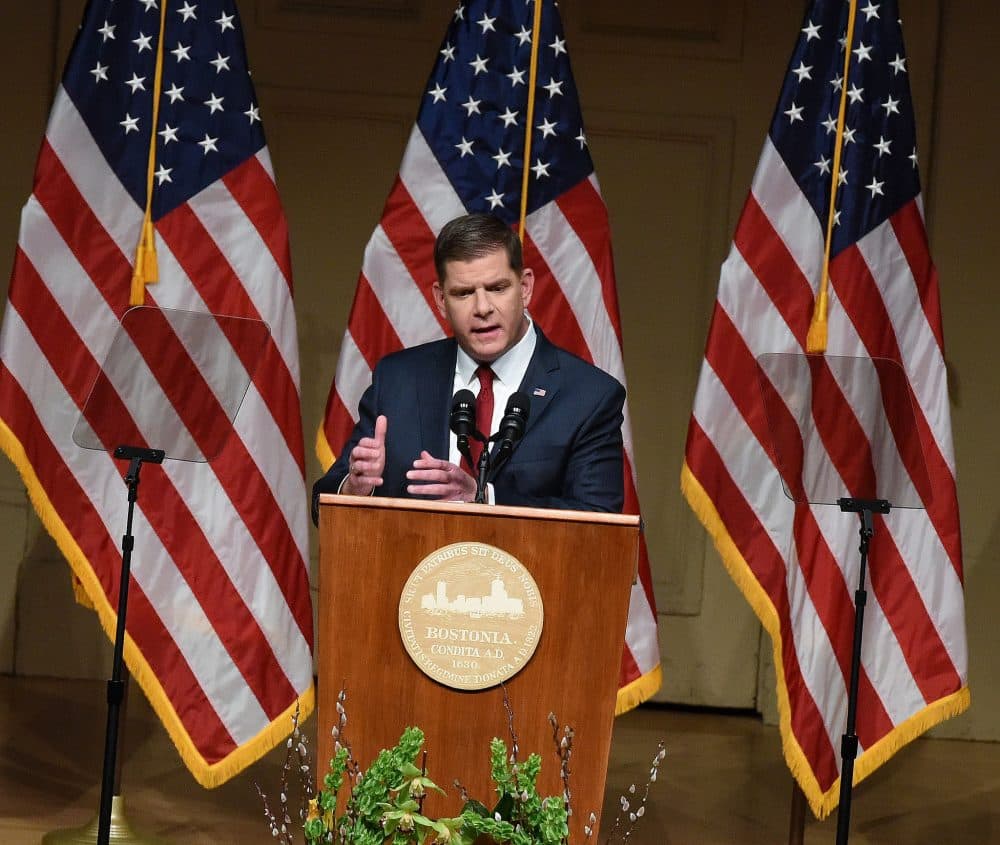Advertisement
Walsh Promises $1 Billion To 'BuildBPS' — But Just What Is BuildBPS?

Boston Mayor Marty Walsh announced in his State of the City address Tuesday night that the city will commit $1 billion over 10 years to BuildBPS, a master facilities plan for Boston Public Schools that is still in the making.
Walsh called the next 10 years “a new era of school investment” — one that he hopes will end with “high-quality 21st-century classrooms for every student.”
The details of the BuildBPS program are sketchy, and the debates over distributing resources or moving students could prove contentious. But there is widespread agreement that the district, as a whole, needs more than a fresh coat of paint.
The billion-dollar commitment will begin to fulfill a promise Walsh made three years ago at his inauguration to rebuild the city’s “long-neglected and antiquated school buildings.” (Almost two-thirds of the system’s 132 buildings date from before the Second World War.)
At a press briefing Tuesday, Dave Sweeney, Boston's chief financial officer, said the first $700 million for the project will come from the city's capital fund.
The rest, he expects, will come from the Massachusetts School Building Authority, the quasi-independent, taxpayer-funded group that helps finance improvements to public schools across the Commonwealth.
The city hasn't traditionally drawn on MSBA funding for its renovation projects. But doing just that was part of Walsh's plan for the district when he took office. Since then the MSBA has begun to contribute in the city, especially in the construction of the Dearborn 6-12 STEM Academy, Boston's newest school building (due to open in 2018).
There's a popular appetite for change when it comes to school facilities. A survey this fall of BPS stakeholders — parents, teachers, students and staff — found widespread dissatisfaction with the state of the school buildings they work and learn in every day.
Sixty percent of those surveyed described the facilities as in “fair” or “poor” condition. More than half said they were missing essential technology. Many worried about cleanliness and routine maintenance, and nearly everyone — 74 percent — was troubled by the state of the system’s bathrooms.
Those assessments of BPS facilities stand in marked contrast to the 83 percent who approved of the district’s teaching and high academic standards.
The same report found that many schools lack the "specialized spaces" required for comprehensive education. One in four respondents said their school was missing a library, an art room, or a science or computer lab.
And that’s actually an undercount. An institutional review from September found that in fact less than half of the district’s schools had both the staff and the space for a library last year.

It’s clear that the system needs work — maybe even more work than a billion dollars can buy.
Ben Vainer, who’s in charge of strategic initiatives in education at City Hall, said in an interview that the mayor’s commitment should be understood as a minimum. And he added that the opening battery of reports — on demographics, facilities, finances and building capacity — will make triage easier: which buildings simply need renovation and which need to be replaced.
Some accelerated repair jobs are already moving ahead under the plan, city officials added. But for now, the shape BuildBPS will take is almost completely unclear — and under discussion.
In the next few weeks, Vainer said, parents and students can expect a written report compiling what the district has learned and “a BuildBPS dashboard” visualizing the state of repair of the district’s 132 school buildings, as assessed by Symmes Maini & McKee Associates, the planning firm that worked with the city on the master plan.
Last year was marked by public resistance to the closing of Mattapan’s Mattahunt Elementary by a vote of the Boston School Committee. And concerns that the building spree will coincide with the closing or consolidation of a number of low-performing schools date back to 2015, when a McKinsey report commissioned by the mayor recommended reducing the size of the district's physical footprint.
Vainer insisted that those decisions haven't been made yet, that no list of school closings is forthcoming and that “the aging of a building is not at all the determinant” of whether a school will face closure.
At the Tuesday briefing, Rahn Dorsey, the mayor's education chief, added that BuildBPS decisions will take place “neighborhood by neighborhood,” and changes will come only after discussion with the people who learn and work there.
At the moment it's too early to say how the district will cope with the biggest remaking of its physical plant in decades. But the conversation, and a lot of aspirations, were launched with the mayor's billion-dollar promise Tuesday night.
